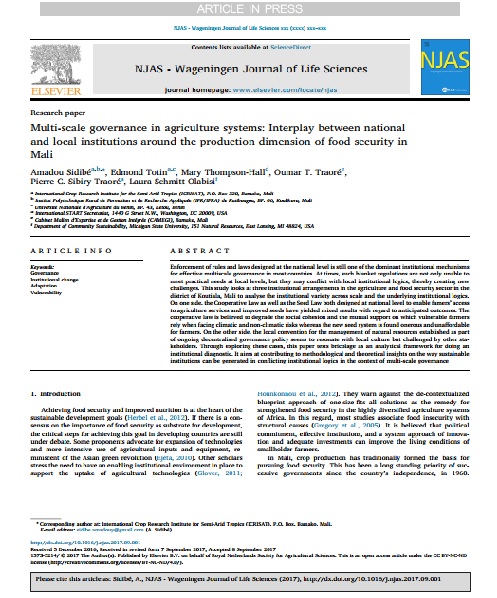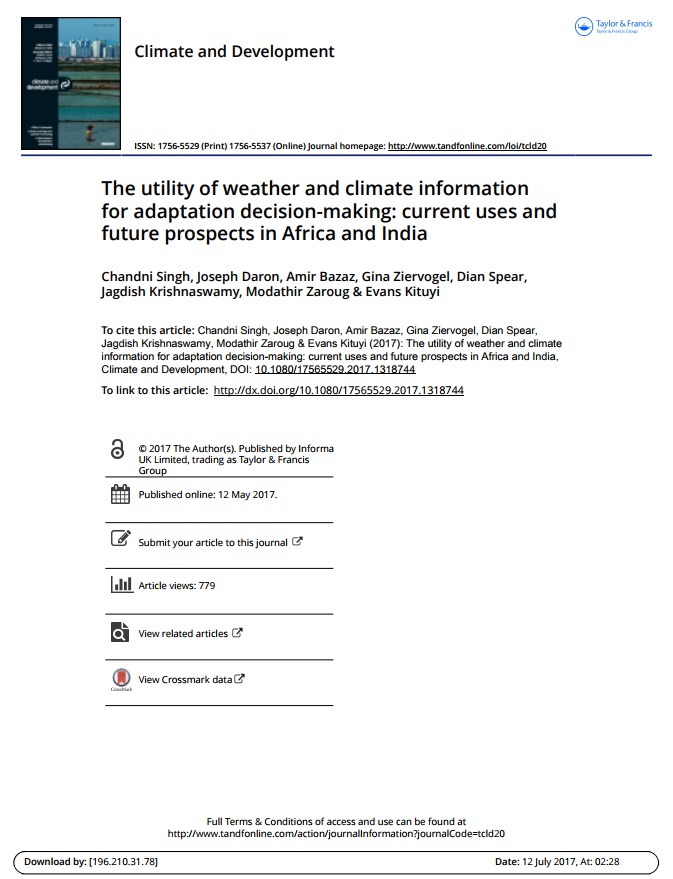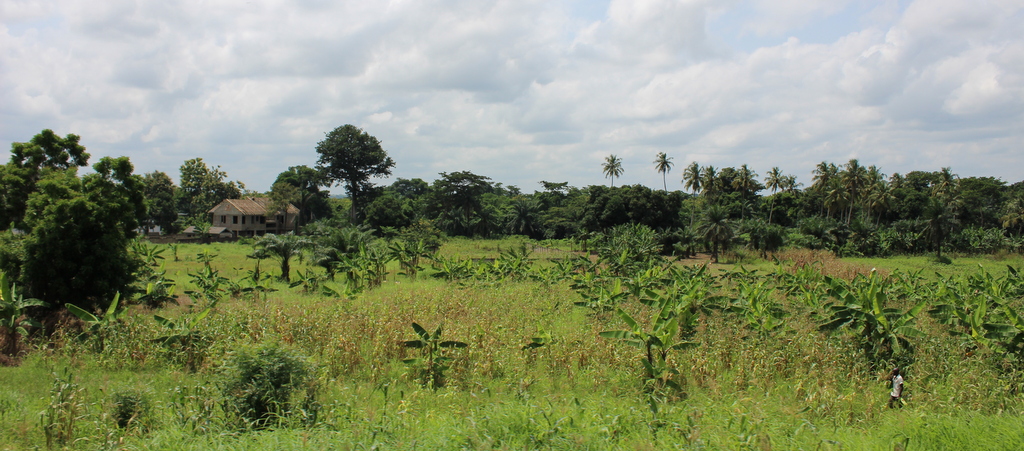
-
Perceptions of ecosystem services provision performance in the face of climate change among communities in Bobirwa sub-district, Botswana (October 2018)
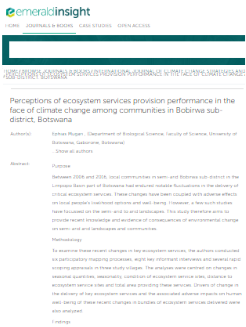
Authors: Ephias Mugari, Hillary Masundire, Maitseo Bolaane, Mark New
Abstract: Between 2006 and 2016, local communities in semi-arid Bobirwa sub-district in the Limpopo Basin part of Botswana had endured notable fluctuations in the delivery of critical ecosystem services. These changes have been coupled with adverse effects on local people’s livelihood options and well-being. However, a few such studies have focussed on the semi-arid to arid landscapes. This study therefore aims to provide recent knowledge and evidence of consequences of environmental change on semi-arid arid landscapes and communities. Read the full paper here
-
Identifying hotspots in land use land cover change and the drivers in a semi-arid region of India (August 2018)
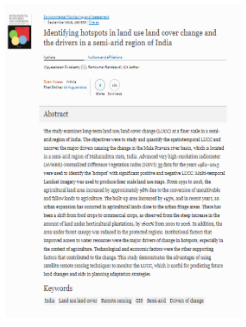
Identifying hotspots in land use land cover change and the drivers in a semi-arid region of India
Authors: Vijayasekaran Duraisamy, Ramkumar Bendapudi, Ajit Jadhav
Abstract: The study examines long-term land use/land cover change (LUCC) at a finer scale in a semi-arid region of India. The objectives were to study and quantify the spatiotemporal LUCC and uncover the major drivers causing the change in the Mula Pravara river basin, which is located in a semi-arid region of Maharashtra state, India. Advanced very high-resolution radiometer (AVHRR)-Normalized Difference Vegetation Index (NDVI) 3g data for the years 1982–2015 were used to identify the ‘hotspot’ with significant positive and negative LUCC. Multi-temporal Landsat imagery was used to produce finer scale land use maps. From 1991 to 2016, the agricultural land area increased by approximately 98% due to the conversion of uncultivable and fallow lands to agriculture. The built-up area increased by 195%, and in recent years, an urban expansion has occurred in agricultural lands close to the urban fringe areas. There has been a shift from food crops to commercial crops, as observed from the steep increase in the amount of land under horticultural plantations, by 1601% from 2001 to 2016. In addition, the area under forest canopy was reduced in the protected regions. Institutional factors that improved access to water resources were the major drivers of change in hotspots, especially in the context of agriculture. Technological and economic factors were the other supporting factors that contributed to the change. This study demonstrates the advantages of using satellite remote sensing techniques to monitor the LUCC, which is useful for predicting future land changes and aids in planning adaptation strategies. Read the full paper here
Further reading: ASSAR one-page brief
-
Understanding the current state of collaboration in the production and dissemination of adaptation knowledge in Namibia (August 2018)
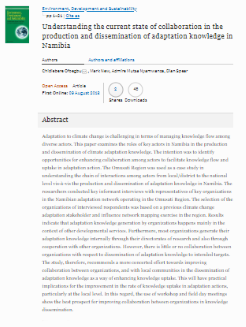
Authors: Chidiebere Ofoegbu, Mark New, Admire Mutsa Nyamwanza, Dian Spear
Abstract: Adaptation to climate change is challenging in terms of managing knowledge flow among diverse actors. This paper examines the roles of key actors in Namibia in the production and dissemination of climate adaptation knowledge. The intention was to identify opportunities for enhancing collaboration among actors to facilitate knowledge flow and uptake in adaptation action. The Omusati Region was used as a case study in understanding the chain of interactions among actors from local/district to the national level vis-Ã -vis the production and dissemination of adaptation knowledge in Namibia. The researchers conducted key informant interviews with representatives of key organizations in the Namibian adaptation network operating in the Omusati Region. The selection of the organizations of interviewed respondents was based on a previous climate change adaptation stakeholder and influence network mapping exercise in the region. Results indicate that adaptation knowledge generation by organizations happens mainly in the context of other developmental services. Furthermore, most organizations generate their adaptation knowledge internally through their directorates of research and also through cooperation with other organizations. However, there is little or no collaboration between organizations with respect to dissemination of adaptation knowledge to intended targets. The study, therefore, recommends a more concerted effort towards improving collaboration between organizations, and with local communities in the dissemination of adaptation knowledge as a way of enhancing knowledge uptake. This will have practical implications for the improvement in the rate of knowledge uptake in adaptation actions, particularly at the local level. In this regard, the use of workshop and field day meetings show the best prospect for improving collaboration between organizations in knowledge dissemination. Read the full paper here
-
Social differences in the vulnerability and adaptation patterns among smallholder farmers: evidence from Lawra District in the Upper West Region of Ghana (June 2018)
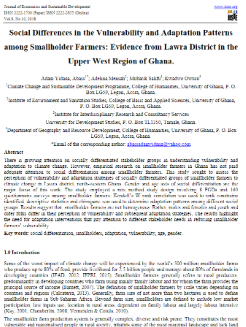
Authors: Adam Yidana Abass, Adelina Mensah, Mubarik Salifu, Kwadwo Owusu
Abstract: There is growing attention on socially differentiated stakeholder groups in understanding vulnerability and adaptation to climate change. However, empirical research on smallholder farmers in Ghana has not paid adequate attention to social differentiation among smallholder farmers. This study sought to assess the perception of vulnerability and adaptation strategies of socially differentiated groups of smallholder farmers to climate change in Lawra district, north-western Ghana. Gender and age axis of social differentiation are the major focus of this work. The study employed a mix method study design involving 8 FGDs and 160 questionnaire surveys among smallholder farmers. Kendell’s W rank correlation was used to rank constrains identified, descriptive statistics and chi-square was used to determine adaptation patterns among different social groups. Results suggest that, smallholder farmers are not homogenous. Rather, males and females and youth and older folks differ in their perception of vulnerability and subsequent adaptation strategies. The results highlight the need for adaptation interventions that pay attention to different stakeholder needs in reducing smallholder farmers’ vulnerability. Read the full paper here
-
Risks and responses in rural India: Implications for local climate change adaptation action (June 2018)

Risks and responses in rural India: Implications for local climate change adaptation action
Authors: Chandni Singh, Andaleeb Rahman, Arjun Srinivas, Amir Bazaz
Abstract: People in drylands face multiple climatic and non-climatic risks and subsequently engage in various response strategies to manage these risks. Research on risk management has typically focussed on a static, location-specific understanding of risk and response. However, empirical evidence suggests that risks and vulnerability vary across space and time. Increasingly, responses traverse multiple locations e.g. people move across rural and urban areas, women move beyond the household/community to earn additional incomes. To highlight this dynamic reality of risks and responses, we study livelihood transitions in South India. We unpack risk and response portfolios across scales – household, community, and sub-national (district) levels – and classify them as coping, adaptive and maladaptive. Our findings emphasise that present responses do not necessarily qualify as climate change adaptation strategies. While certain strategies do improve household wellbeing in the short run, there is relatively lower evidence to suggest an increase in adaptive capacity to deal with climatic risks in the future. These findings point to critical gaps in understanding current risk management and how it can contribute to local adaptation policymaking and implementation. Read the full paper here
-
Temperature and precipitation extremes under current, 1.5°C and 2.0°C global warming above pre-industrial levels over Botswana, and implications for climate change vulnerability (June 2018)
Recognising the dynamics that surround drought impacts
Authors: Roger Few and Mark Tebboth
Abstract: The argument that the impacts of extreme events are to large extent contingent on how stresses are managed – at various scales – is already well established in thought and practice. What we feel is not so often considered is the wider interaction of drought with other environmental and societal dynamics. These dynamics significantly shape the nature and extent of drought impacts, and, equally, shape the chances of success of drought response measures. Moreover, the rapidity of many of these societal dynamics is likely to outstrip the pace of long-term changes in climatic conditions, underlining why it is crucial not to focus narrowly on anthropogenic climate change and variability when discussing future risk from droughts. In this Think Note we use examples from research in East Africa to illustrate the interaction of drought with a set of other dynamics in the lives of pastoralists and agro-pastoralists. Read more here
-
Livelihoods on the edge without a safety net: The case of smallholder crop farming in North-Central Namibia (June 2018)
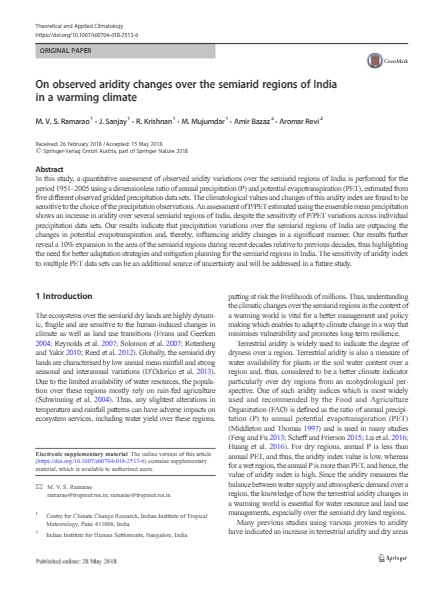
Observed aridity changes over the semiarid regions of India in a warming climate
Authors: M. V. S. Ramarao, J. Sanjay, R. Krishnan, M. Mujumdar, Amir Bazaz, Aromar Revi
Abstract: In this study, a quantitative assessment of observed aridity variations over the semiarid regions of India is performed for theperiod 1951–2005 using a dimensionless ratio of annual precipitation (P) and potential evapotranspiration (PET), estimated fromfive different observed gridded precipitation data sets. The climatological values and changes of this aridity index are found to besensitive to the choice of the precipitation observations. An assessment of P/PET estimated using the ensemble mean precipitationshows an increase in aridity over several semiarid regions of India, despite the sensitivity of P/PET variations across individualprecipitation data sets. Our results indicate that precipitation variations over the semiarid regions of India are outpacing thechanges in potential evapotranspiration and, thereby, influencing aridity changes in a significant manner. Our results furtherreveal a 10% expansion in the area of the semiarid regions during recent decades relative to previous decades, thus highlightingthe need for better adaptation strategies and mitigation planning for the semiarid regions in India. The sensitivity of aridity indexto multiple PET data sets can be an additional source of uncertainty and will be addressed in a future study. Read the full paper here
-
Climate adaptation and water scarcity in Southern Africa (May, 2018)

Large-Scale Transdisciplinary Collaboration for Adaptation Research: Challenges and Insights
Authors: Georgina Cundhill, Blane Harvey, Mark Tebboth, Logan Cochrane, Bruce Currie-Alder, Katharine Vincent, Jon Lawn, Robert. J. Nicholls, Lucia Scodanibbio, Anjal Prakash, Mark New, Philippus Wester, Michele Leone, Daniel Morchain, Eva Ludi, Jesse DeMaria-Kinney, Ahmed Khan, and Marie-Eve Landry
Abstract: An increasing number of research programs seek to support adaptation to climate change through the engagement of large-scale transdisciplinary networks that span countries and continents. While transdisciplinary research processes have been a topic of reflection, practice, and refinement for some time, these trends now mean that the global change research community needs to reflect and learn how to pursue collaborative research on a large scale. This paper shares insights from a seven-year climate change adaptation research program that supports collaboration between more than 450 researchers and practitioners across four consortia and 17 countries. The experience confirms the importance of attention to careful design for transdisciplinary collaboration, but also highlights that this alone is not enough. The success of well-designed transdisciplinary research processes is also strongly influenced by relational and systemic features of collaborative relationships. Relational features include interpersonal trust, mutual respect, and leadership styles, while systemic features include legal partnership agreements, power asymmetries between partners, and institutional values and cultures.
In the new arena of large-scale collaborative science efforts, enablers of transdisciplinary collaboration include dedicated project coordinators, leaders at multiple levels, and the availability of small amounts of flexible funds to enable nimble responses to opportunities and unexpected collaborations. Read the full paper here
-
Wells and Well-being in South India Gender Dimensions of Groundwater Dependence (April 2018)

Wells and Well-being in South India Gender Dimensions of Groundwater Dependence
Authors: Divya Susan Solomon, Nitya Rao
Abstract: Groundwater has played a pivotal role in transforming the rural agrarian landscape, augmenting rural livelihoods and improving household well-being. What role does the growing prevalence and importance of groundwater play in intra-household relations, particularly the gendered divisions of labour and use of assets? The impacts of failed borewells on gendered vulnerabilities, identities and well-being have been explored. Research indicates that groundwater usage in semi-arid regions has increased the short-term resilience of communities in the region, but has simultaneously increased gendered risks, especially for smallholders, by promoting unsustainable livelihood trends and risky coping strategies to groundwater shortages. Read the full publication here
-
Tracing back to move ahead: a review of development pathways that constrain adaptation futures (March 2018)

Tracing back to move ahead: a review of development pathways that constrain adaptation futures
Authors: Sumetee Pahwa Gajjar, Chandni Singh &Tanvi Deshpande
Abstract: Exponents of transformation in the context of climate change strongly articulate the challenges associated with switching from current, potentially maladaptive development trajectories, onto future pathways that are climate responsive. Although scholarship on maladaptation highlights the dangers of path dependency, the concept is under-applied for understanding the potential outcomes of development trajectories that result in what we call an adaptation-constrained space. By conducting case-study analysis based on secondary review, we trace implications of particular development trajectories, in urban and rural India. The first case examines how urbanization in Bangalore city has decreased the capacity to respond to concurrent risks of flooding and water scarcity while the second charts how agricultural policies in India have narrowed local capacity to deal with climatic and non-climatic uncertainties. Using a historical perspective, we identify triggers of change in local and regional development, which have led to an adaptation-constrained space. We find that both pathways display irreversible lock-ins and inherent trade-offs which entrench inequities (through differential capacity and agency to access resources and influence future development). We argue that such development pathways are potentially maladaptive. Whether they are expected to deal with climate impacts or to meet development goals, the fact that they constrain current and future adaptive capacity at multiple levels, is why we consider them maladaptive. As India undertakes large investments in development and climate change adaptation, this paper adds to the relatively low policy debate on how development trajectories, physically and socially, limit the possibilities for future adaptation. We propose that policy-makers and planners first acknowledge how development trajectories acquire dominance, and then begin empowering normative alternatives that open future adaptation options. More
-
Using Life Histories to Understand Temporal Vulnerability to Climate Change in Highly Dynamic Contexts (December 2017)
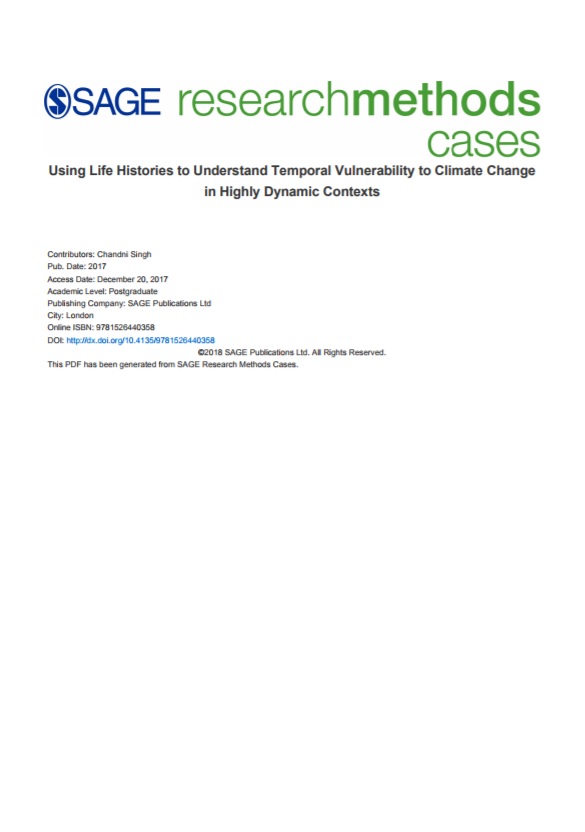
Authors: Chandni Singh
Abstract: Climate change research has often been critiqued for focussing on abstract impacts far into the future that are not perceived and understood in the context of daily life. This case proposes the use of life history interviewing as a methodological approach to study how people perceive and negotiate multiple risks to their lives and livelihoods (one of which may be climate variability) in highly dynamic contexts such as dryland areas. The case examines vulnerability to climate change (among other risks) at household and intrahousehold levels to uncover how personal attributes such as caste, age, and gender, as well as contextual factors such as reduced natural resources and socio-political trajectories shape people’s daily lives, their livelihood choices, and aspirations for the future. Using research conducted in two districts in Southern India, I demonstrate how life histories can expand the existing methodological toolkit available to social scientists working on climate change vulnerability and contribute to understanding the temporality inherent in livelihood decisions, the often-intangible aspirations that motivate people’s choices, and how household responses are tapestries of negotiations made within their immediate and larger environment. Read the full paper here
-
Mental models of food security in rural Mali (December 2017)

Mental models of food security in rural Mali
Authors: Louies Rivers III, Udita Sanga, Amadou Sidibe, Alexa Wood, Rajiv Paudel, Sandra T. MarquartâPyatt, Arika LigmannâZielinska, Laura Schmitt Olabisi, Eric Jing Du, Saweda LiverpoolâTasie
Abstract:
Recent estimates indicate that 12% of the global population is likely to have suï¬ered from chronic hunger, due to lack of enough food for an active and healthy life. West Africa, speciï¬cally across the Sahel countries, is acutely vulnerable to food insecurity concerns. Mail is emblematic of this problem with approximately 4.6 million citizens considered food insecure. Food security poses formidable challenges. Studies have shown that in order to understand food insecurity and identify steps for eï¬ective intervention, there is a need to apprehend the food systems and food in/security in a holistic way beyond production alone. Understanding the behavioral aspects of food security is critical in the African context where agriculture, while oriented toward basic subsistence, remains embedded in social system including the social dynamics of households, extended families, and communities. This exploratory work focuses on developing a nuanced understanding of food security and adaptive behaviors to current challenges to food security at the household level with a distinct focus on inter- and intra-family behavioral dynamics in rural, southern Mali. Using mental models methodology, we developed two inï¬uence diagrams and a set of sub-models that represent rural households’ mental models of food security under traditional conditions and under conditions of external pressures. These models suggest that food security in rural Mali is at considerable risk due to the inï¬uence of external challenges, such as climate change, on traditional behaviors and a lack of easily accessible corresponding behavioral adaptations. Read the full paper here
-
Can scenario planning catalyse transformational change? Evaluating a climate change policy case study in Mali (November 2017)

Authors: Edmond Totin, James R. Butler, Amadou Sidibé, Samuel Partey, Philip K. Thornton, Ramadjita Tabo
Abstract: The potential of participatory scenario processes to catalyse individual and collective transformation and policy change is emphasised in several theoretical reflections. Participatory scenario processes are believed to enhance participants’ systems understanding, learning, networking and subsequent changes in practices. However, limited empirical evidence is available to prove these assumptions. This study aimed to contribute to this knowledge gap. It evaluates whether these outcomes had resulted from the scenario planning exercise and the extent to which they can contribute to transformational processes. The research focused on a district level case study in rural Mali which examined food security and necessary policy changes in the context of climate change. The analyses of interviews with 26 participants carried out 12 months after the workshop suggested positive changes in learning and networking, but only limited influence on systems understanding. There was limited change in practice, but the reported changes occurred at the individual level, and no policy outcomes were evident. However, by building the adaptive capacity of participants, the scenario process had laid the foundation for ongoing collective action, and potential institutional and policy transformation. We conclude that to enhance the resilience of agricultural and food systems under climate change, participatory scenario processes require a broader range of cross-scale actors’ engagement to support transformational changes. Such process will both catalyse deeper learning and more effective link with national level policymaking process. In addition, individual scenario planning exercises are unlikely to generate sufficient learning and reflection, and instead they should form one component of more extensive and deliberate stakeholder engagement, learning and evaluation processes. Read the full paper here
-
Using participatory modeling processes to identify sources of climate risk in West Africa (October 2017)
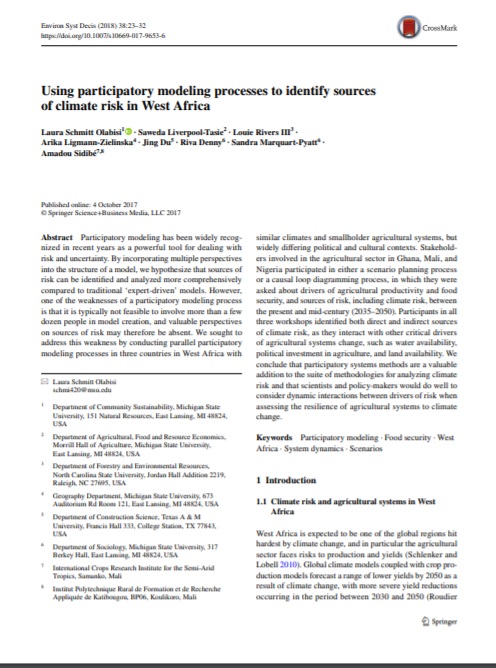
Using participatory modeling processes to identify sources of climate risk in West Africa
Authors: Laura Schmitt Olabisi, Saweda Liverpool-Tasie, Louie RiversIII, Arika Ligmann-Zielinska, Jing Du, Riva Denny, Sandra Marquart-Pyatt, Amadou Sidibé
Abstract: Participatory modeling has been widely recognized in recent years as a powerful tool for dealing with risk and uncertainty. By incorporating multiple perspectives into the structure of a model, we hypothesize that sources of risk can be identified and analyzed more comprehensively compared to traditional ‘expert-driven’ models. However, one of the weaknesses of a participatory modeling process is that it is typically not feasible to involve more than a few dozen people in model creation, and valuable perspectives on sources of risk may therefore be absent. We sought to address this weakness by conducting parallel participatory modeling processes in three countries in West Africa with similar climates and smallholder agricultural systems, but widely differing political and cultural contexts. Stakeholders involved in the agricultural sector in Ghana, Mali, and Nigeria participated in either a scenario planning process or a causal loop diagramming process, in which they were asked about drivers of agricultural productivity and food security, and sources of risk, including climate risk, between the present and mid-century (2035–2050). Participants in all three workshops identified both direct and indirect sources of climate risk, as they interact with other critical drivers of agricultural systems change, such as water availability, political investment in agriculture, and land availability. We conclude that participatory systems methods are a valuable addition to the suite of methodologies for analyzing climate risk and that scientists and policy-makers would do well to consider dynamic interactions between drivers of risk when assessing the resilience of agricultural systems to climate change.
-
Multi-scale governance in agriculture systems: Interplay between national and local institutions around the production dimension of food security in Mali (September 2017)
-
The utility of weather and climate information for adaptation decision-making: current uses and future prospects in Africa and India (May 2017)
-
How do we assess vulnerability to climate change in India? A systematic review of literature (February 2017)

How do we assess vulnerability to climate change in India? A systematic review of literature
Authors: Chandni Singh, Tanvi Deshpande, Ritwika Basu
When trying to prioritise adaptation efforts, it is crucial to understand which people, places and systems are the most vulnerable to climate changes. This is particularly important in countries like India where multiple non-climatic risks already interact with socio-economic differences to make and keep people vulnerable. So how do we determine those most vulnerable to climate change? Many different vulnerability assessment tools have been designed for this purpose, but their effectiveness has not been interrogated. Through a review of key literature the authors set out to do this interrogation, asking these four questions for each assessment tool:
-
How is vulnerability conceptualised (vulnerability of who/what, vulnerability to what)?
-
Who does the vulnerability assessments?
-
How is vulnerability assessed (which methods, at what scale of time and place)?
-
How do these methods affect the assessment outcomes?
The findings raise important concerns about the ways that assessment tools are designed and implemented:
-
Assessment methods are affected by the disciplinary traditions, methodological approaches, and often-unstated motivations of those who design them.
-
Although most assessments acknowledge the importance of scale (of time and place) in determining vulnerability, very few actually integrate scale in their methods.
-
Such methodological myopia potentially overlooks how social differences, ecological shifts, and institutional dynamics construct and perpetuate vulnerability.
-
Most vulnerability assessments are performed in rural areas with relatively few performed in urban and peri-urban settlements. Yet it is in these transition areas that vulnerabilities can be heightened. Read the full paper
-
-
Adaptation to climate change or non-climatic stressors in semi-arid regions? Evidence of gender differentiation in three agrarian districts of Ghana (November 2016)
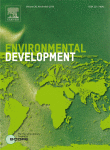
What if gender became an essential, standard element of Vulnerability Assessments?
Authors: Daniel Morchain, Giorgia Prati, Frances Kelsey & Lauren Ravon
Abstract: Vulnerability Assessments (VAs) can be useful tools for providing key insights for nongovernment organisations and other development actors, including governments. Not only can they provide an extensive, ‘landscape-wide’ understanding of vulnerability and its underlying causes in a specific context, but this understanding can be jointly owned by all participants. They can thus be used for designing risk reduction and resilience-building measures, programmes, or projects that affect specific groups within a community or the landscape. Beyond that, VAs can provide a platform that promotes interaction among otherwise disconnected stakeholders, as well as the evidence and argumentation for community groups to engage in advocacy with local and municipal/district authorities. This article draws on our combined experience as development practitioners, and considers what we have learnt about the importance of integrating gender issues into VAs. Read the full paper here
